| کد مقاله | کد نشریه | سال انتشار | مقاله انگلیسی | نسخه تمام متن |
|---|---|---|---|---|
| 2184276 | 1095820 | 2015 | 18 صفحه PDF | دانلود رایگان |
• The chemotaxis histidine kinase CheA has on-state and off-state that depend on conformational dynamics.
• The substrate domain (P1) is sequestered in the off-state by interactions that involve the adjacent subunit.
• Structural changes at the ATP pocket relieve P1 inhibition.
• The structure of the minimal active unit containing the kinase and dimerization domain is consistent with receptor array integration and explains trans subunit phosphorylation.
During bacterial chemotaxis, transmembrane chemoreceptor arrays regulate autophosphorylation of the dimeric histidine kinase CheA. The five domains of CheA (P1–P5) each play a specific role in coupling receptor stimulation to CheA activity. Biochemical and X-ray scattering studies of thermostable CheA from Thermotoga maritima determine that the His-containing substrate domain (P1) is sequestered by interactions that depend upon P1 of the adjacent subunit. Non-hydrolyzable ATP analogs (but not ATP or ADP) release P1 from the protein core (domains P3P4P5) and increase its mobility. Detachment of both P1 domains or removal of one within a dimer increases net autophosphorylation substantially at physiological temperature (55 °C). However, nearly all activity is lost without the dimerization domain (P3). The linker length between P1 and P3 dictates intersubunit (trans) versus intrasubunit (cis) autophosphorylation, with the trans reaction requiring a minimum length of 47 residues. A new crystal structure of the most active dimerization-plus-kinase unit (P3P4) reveals trans directing interactions between the tether connecting P3 to P2–P1 and the adjacent ATP-binding (P4) domain. The orientation of P4 relative to P3 in the P3P4 structure supports a planar CheA conformation that is required by membrane array models, and it suggests that the ATP lid of CheA may be poised to interact with receptors and coupling proteins. Collectively, these data suggest that the P1 domains are restrained in the off-state as a result of cross-subunit interactions. Perturbations at the nucleotide-binding pocket increase P1 mobility and access of the substrate His to P4-bound ATP.
Figure optionsDownload high-quality image (255 K)Download as PowerPoint slide
Journal: Journal of Molecular Biology - Volume 427, Issue 24, 4 December 2015, Pages 3890–3907
